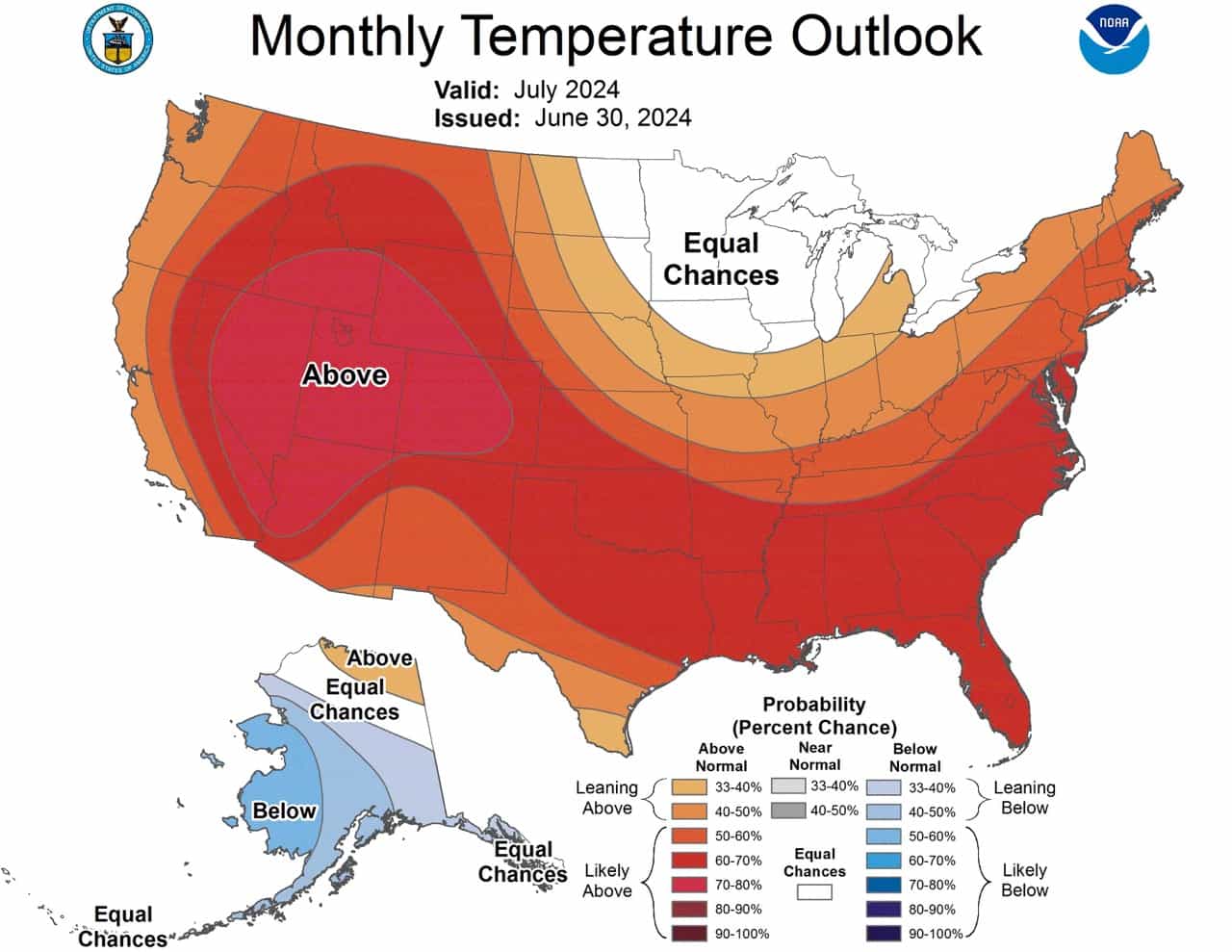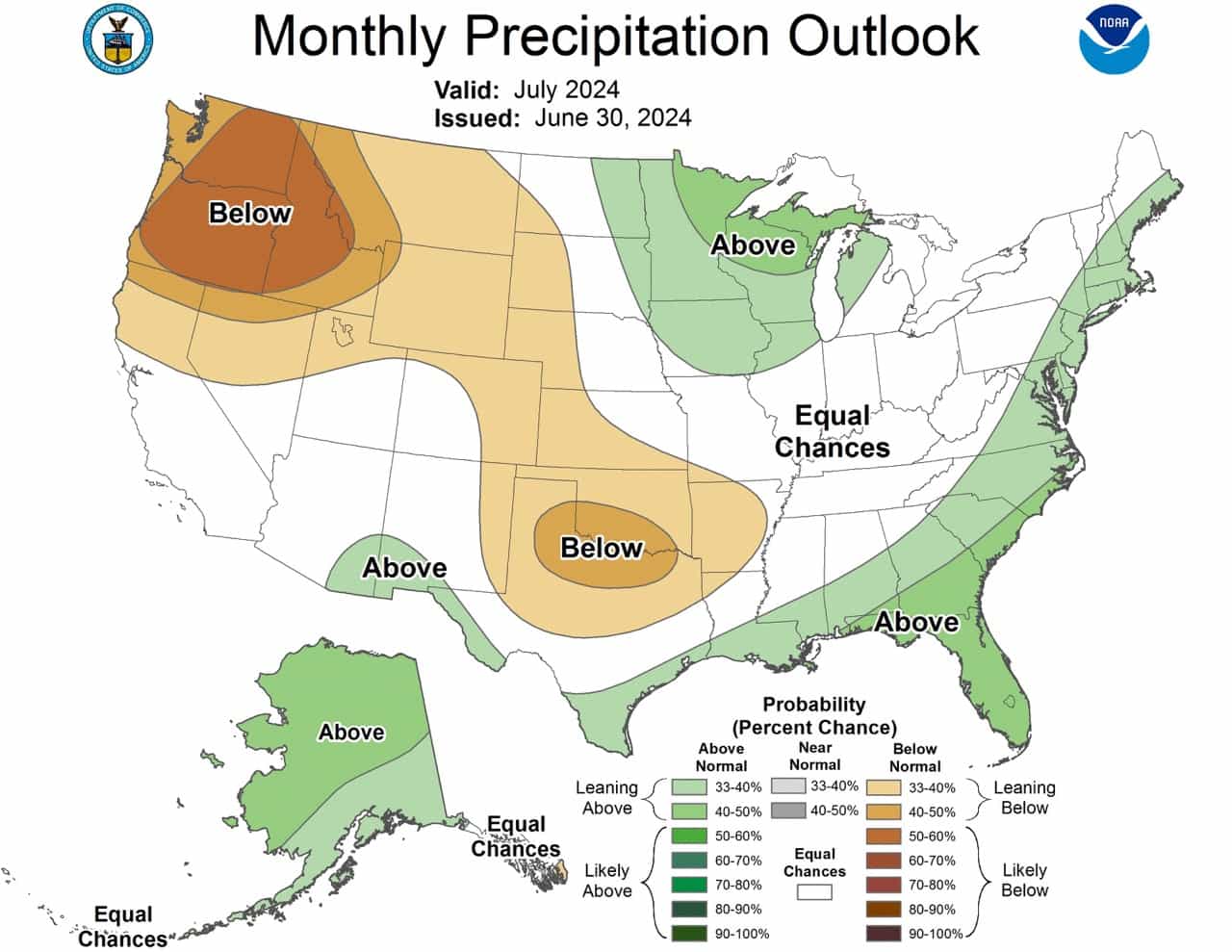
On Sunday, the NOAA released its outlook for July 2024. Much of the Western U.S. is expected to experience above-normal temperatures, with the Southwest facing potentially excessive heat. Precipitation patterns vary across the country. Alaska is likely cooler and wetter than usual, except for its eastern North Slope and Panhandle regions.
Here’s an AI-generated summary of the July 2024 outlook for temperature and precipitation, broken down by region. The full discussion is at the bottom.
Temperature:
Western U.S.:
- Great Basin, Southwest, and Intermountain West: Very high chance (70-80%) of above-normal temperatures
- California and Pacific Northwest: Above-normal temperatures, including potentially excessive heat in California during the first week
- Northern Rockies: Initially near or slightly below normal, then shifting to above normal
Northern Plains and Upper Great Lakes:
- Equal chances of above-, near-, or below-normal temperatures
- Some cooler temperatures are possible early in the month
Southern Plains, Texas, Southeast, Ohio Valley, Mid-Atlantic, and New England:
- Elevated odds of above-normal temperatures
Alaska:
- Most of the state: Below-normal temperatures likely
- Eastern portion of the North Slope: Possibly above-normal temperatures due to long-term trends
Precipitation:
Western U.S.:
- Desert Southwest: Equal chances of above-, near-, or below-normal precipitation, with potential for above-normal near the southern borders of New Mexico and Arizona
- Pacific Northwest and Northern Rockies: Below-normal precipitation likely, but with reduced probability compared to earlier forecasts
Upper Mississippi Valley:
- Above-normal precipitation is favored, especially early in the month
Red River Valley (Oklahoma and Texas):
- Below-normal precipitation favored
Gulf Coast, Florida, and East Coast:
- Slightly above-normal precipitation is expected, with some uncertainty due to potential tropical activity
Alaska:
- Most of the state: Above-normal precipitation expected
- Panhandle: Equal chances of above-, near-, or below-normal precipitation
The outlook notes uncertainty due to potential tropical activity, including Hurricane Beryl and disturbances in the Gulf of Mexico and the Atlantic. It also mentions that neither El Niño Southern Oscillation (ENSO) nor the Madden-Julian Oscillation (MJO) are expected to impact the weather patterns in July 2024 significantly.

30-DAY OUTLOOK DISCUSSION FOR JULY 2024 The updated July 2024 temperature and precipitation outlooks for the contiguous U.S. (CONUS) and Alaska (AK) take into account the most recently observed physical drivers and the latest initializations from the ensemble suites of the dynamical models (ECMWF, GEFSv12, GEM, CFSv2, and JMA). Neither El Niño Southern Oscillation (ENSO) nor the Madden-Julian Oscillation (MJO) are expected to have a meaningful impact on the eventual temperature and precipitation outcome over CONUS and AK. Niño3.4 anomalies indicate ENSO neutral conditions, although 200-hPa velocity potential anomalies are beginning to resemble a La Niña background state with enhanced divergence over the Maritime Continent and convergence farther east. The MJO is currently weak, with any remaining signal indicating the convectively active phase over the Indian Ocean. Some ensemble suites of the dynamical models forecast a strengthening MJO propagating to the Maritime Continent. However, convection in this region would also be consistent with an emerging La Niña. Regardless, the Northern Hemisphere extratropical teleconnections to anomalous tropical convection are weak during July. In the extratropics, sea surface temperature (SST) and soil moisture anomalies remain largely unchanged from the original outlook. Namely, below normal coastal SSTs are still observed along the western coast of Alaska and the West Coast, particularly near California. Above normal coastal SSTs are found along the Gulf Coast and East Coast. Soil moisture anomalies are strongly positive in the Upper Mississippi Valley. They are negative from the Central Plains to the Mid-Atlantic. Soils are becoming increasingly dry across southern OK and northern Texas. Despite heavy rains earlier in June, the recent ~3 weeks have been very dry along the Red River Valley. Significant updates to the temperature and precipitation outlooks for July are largely related to short term model output for Week 1, which typically has high forecast skill. The overall 500-hPa height pattern during Week 1 features very strong ridging developing along the West Coast, transient troughing in the Northern Plains, and downstream ridging over the East Coast. This pattern differs from model initializations last week, which failed to predict the ridge along the West Coast and the depth of the trough in the Northern Plains. Over AK, ridging is expected over the southern half of the state and troughing is anticipated along the North Slope. This pattern leads to a moist onshore flow from the Bering Strait. As the month of July progresses into Weeks 2, 3, and 4, the troughing in the Northern Plains is forecast to diminish; the ridge along the West Coast is expected to move more inland, becoming more centered over the Northern Rockies; and the pattern over Alaska looks to persist. The updated temperature outlook reflects the ridge axis predominantly residing over western CONUS with the highest probabilities for above normal temperatures reaching 70 to 80% over the Great Basin, Southwest, and Intermountain West. In fact, temperatures over California during Week 1 are forecast to be excessively hot, which has necessitated the removal of any equal chances (EC) of above-, near-, or below-normal temperatures along the California coast. The much above normal temperatures are forecast to build northward into the Pacific Northwest as Week 1 progresses, which has also led to the removal of EC in that region. Some relief may occur along the immediate West Coast via sea breeze mechanisms. Entering Week 2, the ridge axis is forecast to move more inland which would push temperatures to above normal values in the Northern Rockies, after a near-normal or slightly-below normal start to the month due to transient troughing in the neighboring Northern Plains. It should also be noted that long-term temperature trends are positive in western CONUS during July, and the temperature outlook reflects that reality. In the Northern Plains and upper Great Lakes, EC is forecast in this updated outlook due to some near- to below-normal temperatures advecting in from the north during Week 1 along with above normal soil moisture anomalies. Most models, including the ECMWF, expect the transient troughing to abate during Week 2, although the GEFS shows some lingering colder than normal temperatures. Farther south and east into the Southern Plains, Texas, Southeast, Ohio Valley, Mid-Atlantic, and New England elevated odds of above normal temperatures are supported by warm air advection downstream of the anticipated troughing in the Northern Plains, long-term trends during July, and strong model agreement. The updated precipitation outlook features a few notable changes. A decent moisture plume during the first week of July is anticipated to produce relatively widespread thunderstorm activity in the Desert Southwest. While this activity lessens during Week 2, there is some indication of it re-emerging as the month unfolds. This tilts the odds from below normal in the original outlook toward a broad region of EC with a small embedded region of above-normal near the southern borders of New Mexico and Arizona. Farther north in the Pacific Northwest and Northern Rockies, below normal precipitation is still expected with strong ridging over the region. However, some monsoon moisture cannot be ruled out, so probabilities for below-normal precipitation were broadly lowered. Above normal precipitation is now favored over the Upper Mississippi Valley due to heavy rain anticipated during Week 1 as a result of the transient troughing. Below normal precipitation is favored along the Red River Valley of Oklahoma and Texas, as most models agree the region will remain dry with below normal soil moisture anomalies and no apparent moisture advection into the region. A thin sliver of above normal precipitation is forecast along the Gulf Coast, Florida, and East Coast. Models are mixed in this region, but ultimately the long term trend and potential tropical activity tilt the odds to above normal. With respect to tropical activity, it should be noted that the eventual track of Hurricane Beryl in addition to disturbances in the Gulf of Mexico and Main Development Region of the Atlantic all lead to uncertainty in the current precipitation outlook. Finally, for Alaska, onshore flow from the Bering Strait is typically a wet and cool pattern during July. Thus, nearly all of the state is favored to have below normal temperatures with the exception of the eastern portion of the North Slope due to long-term trends . Above normal precipitation is also expected over the entire state with the exception of the Panhandle where the influence of the ridge along the West Coast results in EC being forecast.